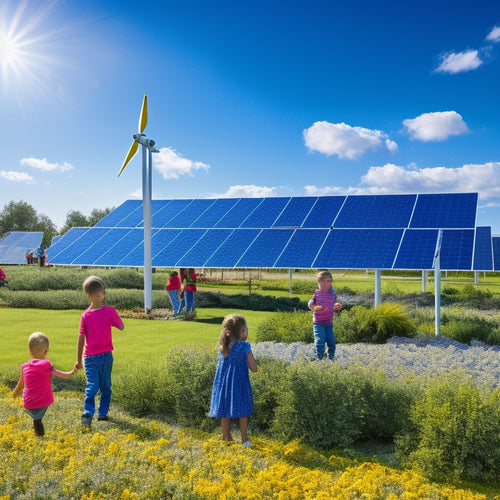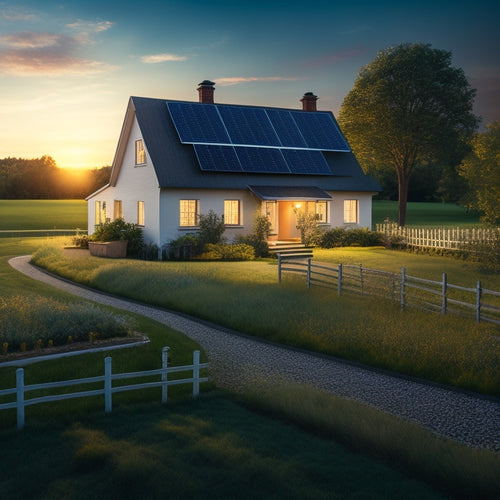
Best High Efficiency Solar Panels for Maximum Energy Savings
Share
You can considerably increase your energy savings by opting for high-efficiency solar panels, which convert up to 23% of sunlight into electricity. Top brands like SunPower, Panasonic, and Trina Solar offer panels with efficiencies ranging from 22% to 24%. By investing in high-efficiency panels, you'll not only reduce your carbon footprint but also enjoy higher electricity output, enhanced durability, and lower energy bills. With the right installation and maintenance, you can maximize your energy savings. Now, investigate the top high-efficiency solar panels and uncover how they can revolutionize your energy production and savings.
Key Takeaways
- High-efficiency solar panels with 22-24% efficiencies, like SunPower's X-Series, maximize energy output and savings.
- Leading manufacturers, including Panasonic and Trina Solar, offer high-performance panels with advanced features.
- High-efficiency panels reduce environmental impact, increase investment returns, and require fewer panels for the same energy output.
- Daily power generation and energy bill reductions vary based on system size, local rates, and energy usage, but can be significant (e.g., 30-80% reduction).
- Key features to look for include high power output, high efficiency rating, low temperature coefficient, durable materials, and advanced features like bifacial technology.
Top High Efficiency Solar Panels
When scouring the market for top high efficiency solar panels, you'll find that manufacturers are constantly pushing the boundaries of energy output.
The latest advancements in solar panel technology have led to a significant increase in energy conversion efficiency, allowing homeowners and businesses to capture more power from the sun.
Currently, the highest efficiency solar panels on the market boast efficiencies ranging from 22% to 24%.
These top-performing panels employ state-of-the-art technology, such as multi-busbar cells and half-cut cells, to minimize energy losses and maximize energy gains.
Leading manufacturers like SunPower, Panasonic, and Trina Solar are at the forefront of this innovation, offering high-efficiency panels with impressive specs.
For instance, SunPower's X-Series Residential Solar Panels boast an impressive 22.8% efficiency rating, while Panasonic's HIT-240 Series modules offer a 21.8% efficiency rating.
As you search for the best high-efficiency solar panels, look for these industry leaders and their latest innovations in solar panel technology.
Benefits of High Efficiency Panels
You're likely considering high-efficiency solar panels because you want to maximize your energy output and reduce your carbon footprint. By opting for high-efficiency panels, you'll not only minimize your environmental impact but also reap significant financial benefits.
High-efficiency solar panels offer several advantages that make them an attractive investment. Here are some key benefits:
| Benefits | Description |
|---|---|
| Increased Energy Output | Higher efficiency ratings translate to more electricity generated per hour of sunlight |
| Reduced Environmental Impact | By producing more energy with fewer panels, you'll lower your carbon footprint and contribute less to greenhouse gas emissions |
| Improved Investment Returns | High-efficiency panels can lead to higher savings on your electricity bills, resulting in a faster return on your investment |
| Enhanced Durability | Premium materials and advanced manufacturing processes guarantee high-efficiency panels last longer and require less maintenance |
How Efficiency Affects Energy Savings
You're likely wondering how a high-efficiency solar panel's increased energy output per hour translates to real-world energy savings.
The answer lies in the panel's ability to generate more power in the same amount of time, which can greatly reduce the overall size of the solar panel system you need.
This, in turn, means you can maximize your energy production while minimizing the space required, making the most of your available roof or ground area.
Energy Output Per Hour
Every hour counts when it comes to generating electricity from the sun, and high-efficiency solar panels can make a significant difference in your energy savings. You want to maximize your energy output per hour, and that's where high-efficiency solar panels come in. They're designed to convert sunlight into electricity more efficiently, resulting in more power per hour.
Here's how high-efficiency solar panels can enhance your energy output per hour:
-
Improved energy conversion: High-efficiency solar panels can convert up to 23% of sunlight into electricity, compared to standard panels that convert around 15-18%. This means you'll generate more power per hour with high-efficiency panels.
-
Enhanced sunlight absorption: High-efficiency solar panels are designed to absorb more sunlight, resulting in more energy generated per hour. This is especially important during peak sun hours when energy demand is high.
-
Increased power output: With high-efficiency solar panels, you can expect to generate more power per hour, even in low-light conditions. This means you'll have more energy available to power your home or business.
- Reduced energy losses: High-efficiency solar panels minimize energy losses, ensuring that more of the sun's energy is converted into usable electricity. This results in more power available per hour.
Panel Size and Space
As the efficiency of solar panels increases, so does the impact on panel size and space requirements. This is vital for you, as you're looking to maximize energy savings. With high-efficiency panels, you can generate more power per unit area, reducing the overall space needed for your solar array.
| Efficiency | Panel Size (sqft) | Space Requirements (sqft) |
|---|---|---|
| 15% | 300 | 2,000 |
| 18% | 250 | 1,600 |
| 20% | 200 | 1,200 |
| 22% | 180 | 1,000 |
| 25% | 150 | 800 |
Key Features to Look for Today
High-efficiency solar panels boast an impressive array of features that set them apart from their lower-efficiency counterparts.
When shopping for the best high-efficiency solar panels, you'll want to prioritize the following key features to maximize your energy savings.
To stay ahead of the curve in solar technology trends, look for panels with:
-
High power output: Measured in watts (W), this indicates the panel's ability to generate electricity. Higher power output means more energy savings.
-
High efficiency rating: Expressed as a percentage, this metric reveals how well the panel converts sunlight into electricity. Higher efficiency ratings result in more energy produced per unit area.
-
Low temperature coefficient: This measures how well the panel performs in high temperatures. A lower temperature coefficient guarantees consistent energy production, even on hot days.
- Durable materials and construction: A sturdy build guarantees the panel withstands environmental stresses and lasts for decades, providing a strong return on investment.
Top Brands for Maximum Output
Several top-tier brands dominate the market for high-efficiency solar panels, offering exceptional performance and maximum output. As you investigate the best options for your energy needs, you'll likely come across industry leaders like SunPower, Panasonic, and LG Solar.
These top solar manufacturers have consistently pushed the boundaries of industry innovations, driving advancements in panel efficiency and energy production.
When it comes to maximum output, brands like Trina Solar and Hanwha Q CELLS offer high-performance panels with impressive wattage ratings. Their state-of-the-art technology and attention to detail guarantee that every panel is optimized for maximum energy harvesting.
You'll also find brands like JA Solar and Canadian Solar, which offer high-efficiency panels with advanced features like bifacial technology and half-cut cells.
These top brands have earned their reputation by providing consistent results and continuously pushing the envelope of what's possible with solar energy.
Comparing Efficiency and Cost
When evaluating top-tier solar panels, you'll inevitably weigh efficiency against cost.
As you explore the world of high-efficiency solar panels, it's essential to understand the relationship between these two vital factors. A thorough cost analysis is important to determine the best value for your investment.
Here are key efficiency metrics to reflect upon when comparing high-efficiency solar panels:
-
Peak Power Output: The maximum power output of a solar panel under ideal conditions, typically measured in watts (W).
-
Efficiency Rating: The percentage of sunlight converted into electricity, with higher ratings indicating better performance.
-
Temperature Coefficient: The rate at which a panel's efficiency decreases as temperature increases, affecting performance in hot climates.
- Fill Factor: A measure of a panel's ability to convert sunlight into usable power, with higher values indicating better performance.
Real-World Energy Savings Examples
You're likely wondering how high-efficiency solar panels can impact your energy costs and daily power generation.
With a well-designed system, you can expect significant energy bill reductions, generating a substantial portion of your daily power needs, and enjoying annual cost savings that add up over time.
Energy Bill Reductions
Frequently, homeowners who invest in high-efficiency solar panels witness a considerable decrease in their energy bills.
By utilizing the power of the sun, you can greatly reduce your energy consumption and save money on your monthly utility bills.
Here are some real-world examples of energy bill reductions achieved through high-efficiency solar panels:
- 30% reduction: A California homeowner with a 5 kW solar panel system reduced their energy bill from $250 to $175 per month.
- 50% reduction: A New York homeowner with a 3 kW solar panel system cut their energy bill from $150 to $75 per month.
- 65% reduction: A Texas homeowner with a 10 kW solar panel system decreased their energy bill from $500 to $175 per month.
- 80% reduction: A Florida homeowner with a 7 kW solar panel system slashed their energy bill from $300 to $60 per month.
Daily Power Generation
By utilizing the power of high-efficiency solar panels, you can generate a significant amount of electricity daily. On average, a typical residential solar panel system can produce between 20-40 kilowatt-hours (kWh) of electricity per day, depending on factors like panel efficiency, system size, and local solar irradiance.
To put this into context, consider that the average American household consumes around 30 kWh of electricity daily. This means that high-efficiency solar panels can cover a substantial portion of your daily energy needs, reducing your reliance on the grid and lowering your energy bills.
It's essential to understand solar production trends and daily energy fluctuations to maximize your energy savings. For instance, solar panels typically produce more power during peak sun hours (usually between 9 am and 3 pm) and less during early morning and late afternoon.
Annual Cost Savings
High-efficiency solar panels translate to tangible cost savings over time. As you generate your own electricity, you reduce your reliance on the grid and lower your utility bills. The amount you save annually depends on factors like your energy usage, local electricity rates, and the size of your solar panel system.
Here are some real-world examples of annual cost savings:
-
$800 in California: With high electricity rates and abundant sunlight, California homeowners can save up to $800 per year with a high-efficiency solar panel system.
-
$600 in New York: In New York, where electricity rates are relatively high, homeowners can save around $600 annually with a high-efficiency solar panel system.
-
$400 in Texas: With lower electricity rates in Texas, homeowners can still save around $400 per year with a high-efficiency solar panel system.
- $1,000 in Hawaii: In Hawaii, where electricity rates are among the highest in the country, homeowners can save up to $1,000 annually with a high-efficiency solar panel system.
These seasonal savings add up to a significant long-term investment in your energy independence.
Factors Reducing Panel Efficiency
Operating at peak performance, high-efficiency solar panels can achieve impressive energy outputs, but various factors can hinder their ability to convert sunlight into electricity efficiently.
As you consider investing in these panels, it's crucial to understand the factors that can reduce their efficiency. Temperature effects, for instance, can decrease panel efficiency by up to 0.5% for every degree Celsius above 25°C.
Shading impact from trees, buildings, or other obstacles can also greatly reduce energy output. Additionally, dust accumulation on the panels can lead to a 1-2% reduction in efficiency.
Inverter efficiency, orientation angle, and installation quality can also affect panel performance. Material degradation and aging performance over time can further reduce efficiency.
Weather conditions, such as high humidity or extreme temperatures, can also impact panel output.
Installation and Maintenance Tips
When planning your solar panel installation, it's essential that you pay close attention to the installation site and process to guarantee peak energy production.
A well-designed installation will maximize your energy savings, while a poorly planned one can lead to reduced efficiency and productivity.
To achieve optimal performance, follow these installation and maintenance tips:
-
Optimize solar panel orientation: Make sure your panels are installed at an angle that allows them to receive direct sunlight for the longest period possible.
-
Perform regular cleaning: Dirt and debris can reduce energy output by up to 25%. Clean your panels every 6-12 months to maintain peak performance.
-
Check for shading: Shading from trees, buildings, or other obstructions can greatly reduce energy production. Make certain your panels receive minimal shading throughout the day.
- Schedule regular maintenance: Regular maintenance checks can help identify and fix potential issues before they impact energy production. Set a maintenance frequency of at least once a year to make sure your system runs smoothly.
Future of High Efficiency Solar
As you investigate the future of high efficiency solar, you'll notice significant advancements in solar energy technology, such as the development of bifacial panels and perovskite cells, which are set to revolutionize the industry.
You can expect these innovations to increase power density, allowing for more energy to be generated in smaller spaces. This upward trend in power density will likely continue, enabling the widespread adoption of solar energy as a viable alternative to fossil fuels.
Solar Energy Advancements
Beyond the current crop of high-efficiency solar panels, researchers are pushing the boundaries of what's possible.
You're likely aware that solar technology innovations are advancing rapidly, but you mightn't know just how far-reaching these advancements are.
-
Bifacial solar cells: Researchers are developing bifacial solar cells that can absorb light from both the front and back sides, increasing energy output by up to 25%.
-
Perovskite solar cells: Scientists are exploring the potential of perovskite solar cells, which have shown higher power conversion efficiency rates than traditional silicon-based cells.
-
Thin-film solar cells: Thin-film solar cells are being developed to reduce material costs and increase efficiency.
These cells use less material than traditional solar panels, making them a promising development for the industry.
- Concentrated photovoltaic (CPV) systems: CPV systems use mirrors or lenses to focus sunlight onto a small area of high-efficiency solar cells, increasing energy output.
These photovoltaic research trends are driving the industry forward, promising even greater energy savings and more efficient systems in the future.
As you consider high-efficiency solar panels, keep an eye on these emerging technologies that will shape the future of solar energy.
Increasing Power Density
You're now looking at the next level of high-efficiency solar panels, where increasing power density is key. This means squeezing more energy out of every square inch of your solar array. By doing so, you'll maximize your energy savings and reduce your carbon footprint.
To accomplish this, manufacturers are developing panels with higher power ratings, often exceeding 400 watts. These high-power panels require advanced power optimization techniques to guarantee each cell operates at its maximum potential.
You'll need to take into account innovative installation techniques, such as bifacial panels that capture energy from both sides, and advanced tracking systems that follow the sun's movement. By combining these technologies, you can increase your system's overall energy yield and reduce the amount of land required for installation.
With increasing power density, you'll be able to generate more electricity from a smaller footprint, making high-efficiency solar panels an attractive option for those seeking maximum energy savings.
Frequently Asked Questions
Can I Install High-Efficiency Solar Panels on My Old Roof?
You'll need a thorough roof inspection before installing high-efficiency solar panels to confirm your old roof can support the added weight and stress; consider factors like structural integrity, roofing material, and installation considerations to secure a safe and efficient setup.
Do High-Efficiency Panels Work Better in Low-Light Conditions?
You'll find that high-efficiency panels excel in low-light conditions due to their superior low light performance, converting more energy from minimal sunlight into usable power through advanced energy conversion technology, maximizing your energy output.
Are High-Efficiency Solar Panels More Prone to Overheating?
You're wondering if high-efficiency solar panels overheat more easily? Well, it's essential to take into account thermal management and heat dissipation; while high-efficiency panels do generate more heat, advanced designs and materials can mitigate this issue, ensuring peak performance.
Can I Mix High-Efficiency and Regular Panels on My Roof?
You think mixing high-efficiency and regular panels is a genius hack, but ironically, it's a recipe for energy loss. Solar panel compatibility is key; mismatched panels reduce overall energy output, so it's essential to compare energy output before making a costly mistake.
Do High-Efficiency Panels Have a Longer Warranty Than Regular Ones?
You'll find that high-efficiency panels often come with longer warranties, typically 25 years or more, compared to regular panels, which usually have 20-25 year warranties, reflecting their longer lifespan and superior performance.
Conclusion
As you utilize the sun's energy, high-efficiency solar panels become the key to releasing maximum savings. Like a skilled conductor, they orchestrate photons into a harmony of electricity, amplifying your returns. By choosing the best, you'll bask in the radiance of reduced bills and a clearer conscience. So, shine bright with the top high-efficiency solar panels, and let the savings illuminate your path to a sustainable future.
Related Posts
-

Solar Power for Community Energy Independence
Solar power is essential for your community's energy independence, offering both environmental and economic benefits....
-

Eco-Friendly Home Design Ideas for Beginners
If you're starting your eco-friendly home design expedition, focus on sustainable materials like recycled wood or rec...
-

Cost-Effective Solar Solutions for Rural Homes
Cost-effective solar solutions can alter your rural home by enhancing energy independence and slashing utility bills....


